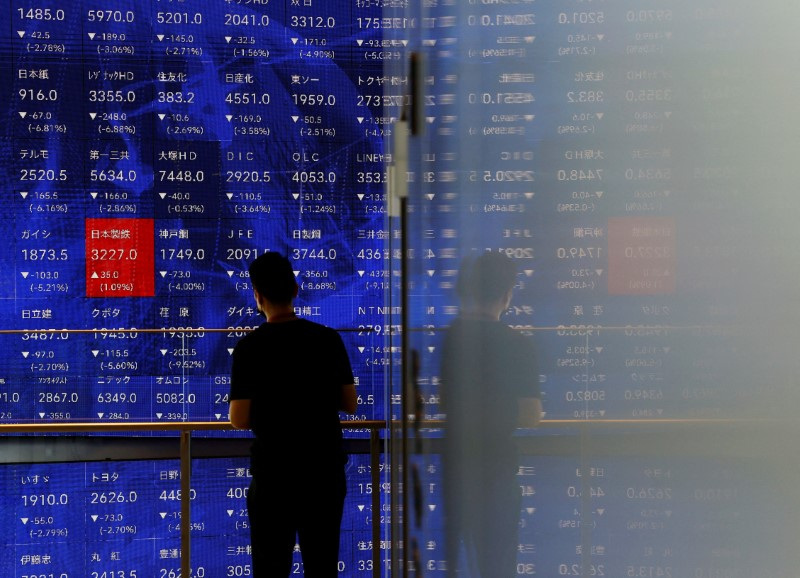Stocks rise, bond yields drop on soft US PPI data
By Koh Gui Qing and Lawrence White
NEW YORK/LONDON (Reuters) -Stocks jumped and bond yields fell on Tuesday after data showed U.S. producer prices increased less than expected in July, reinforcing market expectations that cooling inflation will allow the Federal Reserve to cut interest rates soon.
The producer price index for final demand gained 0.1% last month after rising by an unrevised 0.2% in June, the Labor Department's Bureau of Labor Statistics said on Tuesday. Economists polled by Reuters had forecast the PPI gaining 0.2%.
"The muted 0.1% month-on-month increase in final demand PPI and unchanged core PPI for July is not quite as good as it looks, but it is nevertheless consistent with the Fed’s preferred core PCE prices measure increasing at a below-2% annualised pace," said Paul Ashworth, the chief economist in North America at Capital Economics.
Hopes that rate cuts are in the offing underpinned gains on Wall Street. The S&P 500 jumped 1.4%, the Dow Jones Industrial Average added 0.8% and the Nasdaq Composite climbed 2.2%. MSCI's gauge of stocks across the globe jumped 1.4%.
In line with speculation of monetary policy easing, Treasury yields fell. The benchmark 10-year Treasury yield slipped to 3.8579%, while the two-year Treasury yield fell to 3.9543%.
Europe's STOXX 600 index gained 0.5%, while Japan's Nikkei jumped more than 3% following a holiday on Monday, a welcome relief after last week's wild swings that began with a massive selloff spurred by a rising yen and fears of a U.S. recession.
"While aftershocks might reveal vulnerabilities, we continue to view recent volatility as being an equivalent of a 'heart palpitation' not a 'cardiac arrest,'" Viktor Shvets, head of global desk strategy at Macquarie Capital, said in a note.
"We also maintain that the nervousness about a U.S. slowdown is overdone."
The yen was firmer against the dollar at 146.84 per dollar, having touched a seven-month high of 141.675 on Monday last week, a far cry from the 38-year lows of 161.96 it was rooted to at the start of July.
A Bank of Japan rate rise last month following bouts of intervention from Tokyo earlier in July wrong-footed investors and led them to bail out of popular carry trades, which use the currency of a low-rate market to fund investments with higher returns.
The latest weekly data to Aug. 6 showed that leveraged funds - typically hedge funds and various types of money managers - closed their positions in the yen at the quickest rate since March 2011.
Given the yen's recent rally, dollar-yen is now more in sync with its yield differential, according to Karsten Junius, chief economist at Bank J. Safra Sarasin.
"Another wave of the yen-funded carry trade unwind will likely push the yen still somewhat higher towards year-end. Yet we do not expect USD-JPY to fall meaningfully below 140," he said.
DATA-HEAVY WEEK
Data this week could sharpen views on the Federal Reserve's next move. Markets are currently evenly split between a 25 basis-point cut or a 50-bp cut at the next meeting in September.
Traders are pricing in 100 bps of cuts this year.
Surprisingly soft payrolls data kicked off the market meltdown at the start of last week but strong U.S. data since then has eased slowdown fears.
Any hints of soft inflationary pressures could cause financial markets to double down on wagers the Fed will sharply cut rates this year, which would weigh on the dollar, said Kristina Clifton, a senior economist at Commonwealth Bank of Australia (OTC:CMWAY ).
U.S. consumer price index data for July is due on Wednesday and expected to show month-on-month inflation ticked up to 0.2%. Retail sales data is scheduled for Thursday.
Euro zone bond yields were little changed. Germany's 10-year yield, the benchmark for the euro zone, fell to 2.182%. It hit its lowest since January at 2.074% last week.
The dollar index , which measures the U.S. currency against six others, dipped 0.32% to 102.75. The euro was rose 0.4% to $1.09730, while sterling was up 0.7% at $1.28490.
In commodities, Brent crude futures fell 1.8% to $80.85 a barrel, while U.S. West Texas Intermediate crude futures slipped 1.9% to $78.5 a barrel. Brent had gained more than 3% on Monday, while U.S. crude futures had risen more than 4%. [O/R]
Source: Investing.com
